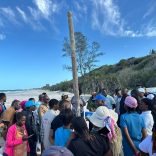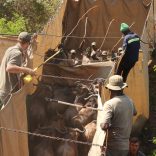Mozambique: Training Inhassoro and Vilankulo practitioners in Nature-based Solutions for climate ...
Watch – INAM issues Weather Alert: Strong winds, heavy rains for Southern Mozambique from tomorrow Wednesday

TVM
Strong winds and rains of up to 300 mm could reach the southern region of the country from tomorrow, Wednesday. Inhambane and Gaza coastal areas may be hit by gust if up to 100 km/h, TVM reports today.
The National Institute of Disaster Management will activate all Risk Management Committees and maintain the National Emergency Operational Center in readiness.
The Mutamba, Inhanombe and Govuro river basins, Inhambane province, and the Limpopo basin in Gaza province are on alert and may see flow increases.
The Maputo, Inkomati and Umbeluzi rivers may also register some rise due to heavy rain, but without danger.
According to the National Institute of Meteorology, an equal phenomenon has already been registered in the country for 6 years.
The coastal zone of Inhambane and Gaza provinces and the city of Maputo in southern Mozambique are expected to receive above-normal rainfall from Wednesday on.
Yesterday in Maputo, the National Institute of Meteorology’s Acácio Tembe had said that rainfall in Inhambane and Gaza could reach 300 mm over three days, while Maputo city could expect more that 70 mm in less than 24 hours. Acácio Tembe spoke during a press conference in which the National Institute of Disaster Management (INGC) also participated.
Tembe attributed the weather to a tropical depression that formed over Madagascar and was moving towards the coasts of Gaza and Inhambane at about five kilometers per hour.
“Usually, tropical depressions do not bring very strong winds, but they do bring a lot of precipitation,” Tembe explained, so in the three days that the tropical depression will affect the country, the winds will not be too strong.
He also explained the categorization of tropical systems, noting that it is not a cyclone but a tropical depression. “We started to categorize it as a storm, but at the moment this system falls outside that categorization” he said.
Tembe compared the tropical depression with the storm ‘Dando’, which hit the southern part of the country in January 2012.
“The system bears some resemblance to the ‘Dando’ system of 2012, which brought rains to the province of Inhambane, Gaza and South Africa,” Tembe said, recalling that the 2012 rains caused flooding when the Limpopo River overflowed in Gaza.
Tembe said that the INAM would continue to monitor the development of the phenomenon.
“Every day we update the information every six hours, but we will also update whenever we have relevant information,” he said.
National Emergency Operational Center (CENOE) spokesman Paulo Tomás said he was intensifying precautionary measures and preparedness for climatic phenomena, and that CENOE, the operating arm of INGC, would be active 24 hours a day, as well as activating Emergency Operational Centers in provinces expected to be hit by the tropical depression.
“We will intensify the allocation of goods and materials for possible response action in the event of any extreme phenomenon,” he said, noting that CENOE had not yet cancelled the current orange alert.
He appealed to people living in at-risk areas to follow weather updates carefully.












Leave a Reply
Be the First to Comment!
You must be logged in to post a comment.
You must be logged in to post a comment.